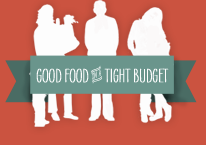 Have you ever been shopping for groceries and wished someone would help you find the foods that are the least scary/gross/toxic/processed for the best price?
Have you ever been shopping for groceries and wished someone would help you find the foods that are the least scary/gross/toxic/processed for the best price?
The Environmental Working Group (EWG) — the folks who brought you the Dirty Dozen list and the (awesome) Skin Deep Cosmetic Database — have set out to do that. Good Food on a Tight Budget might just have the answers. EWG reviewed government surveys and tests [PDF] for nearly 1,200 foods. “We looked at food prices, nutrients, pesticides, environmental pollutants and artificial ingredients and picked the top 100 or so foods that ranked best on balance.”
The new guide zeroes in on whole foods — because, well, most processed and packaged foods just aren’t a good use of money or calories. It breaks down your options by food groups — fruit, vegetables, protein, fats and oils, grains, etc. — and makes recommendations for the foods that offer the most bang for your buck. A continuation of EWG’s Dirty Dozen list, this guide offers some recommendations about what to prioritize buying organic, but it’s clearly written with an eye toward inclusiveness, so assumes that most don’t have the budget for organic.
In the fruit category, for instance, the guide recommends bananas, watermelon, pears, and nectarines — but points out that peaches are generally too toxic to be worth buying conventionally. And, while lettuce and collards are recommended for price, the guide makes a note that, in most cases, broccoli is a lower-pesticide choice than either.
Here are some of our favorite tips from the Good Food on a Tight Budget guide:
- Freeze cheese that starts going bad. Defrosted cheese tastes best melted. Don’t buy shredded cheese — shred it yourself.
- Substitute yogurt for cream and sour cream in recipes. Drain yogurt in a coffee filter to thicken. To cut cost and packaging waste, buy in large containers and measure out small servings.
- Cut and freeze fresh fruit when it’s on sale or overripe. Use later in smoothies, oatmeal, or yogurt (see recipes [PDF]). To eliminate clumping, lay pieces on a tray in the freezer or freeze pureed fruit in ice-cube trays. When frozen, transfer to a bag.
- Don’t be fooled. Read the label. Make sure the word “whole” is in the very first ingredient listed. “Multigrain” or “wheat” isn’t enough. Just because it looks brown doesn’t mean it’s whole grain.
- Start kids off right with whole grains, not white bread and white pasta. If they’re not used to whole grains, mix them in gradually.
- Buy in bulk and stock up during sales. Make your own oatmeal (see recipes [PDF]). Packets cost more and are often loaded with salt and sugar. Buy brown rice in bulk and mix with white rice if needed to lower cost. Buy whole grain bread on sale and save in the freezer.
- Add nuts to oatmeal, cereal, salads and stir-fries for a healthy, hearty meal. Raw nuts are often cheaper. Roast them for a delicious snack. Nuts stay fresh longer in the freezer.
- Whole or cut-up bone-in chicken can be a money saver (see recipe [PDF]). Bake extra and use all week. Buy family-size packs on sale and freeze.
- Soak and cook dried beans to save money. Canned beans save time, but rinse them before using.
- Vegetables about to go bad? Freeze them or make soup (see recipes [PDF]).
- Stock up on long-lasting vegetables and store them in a cool, dry place. Potatoes, carrots, pumpkin, calabaza, and sweet potatoes taste great for several weeks after you buy them. Frozen vegetables and cabbage keep well, too.



